Menu
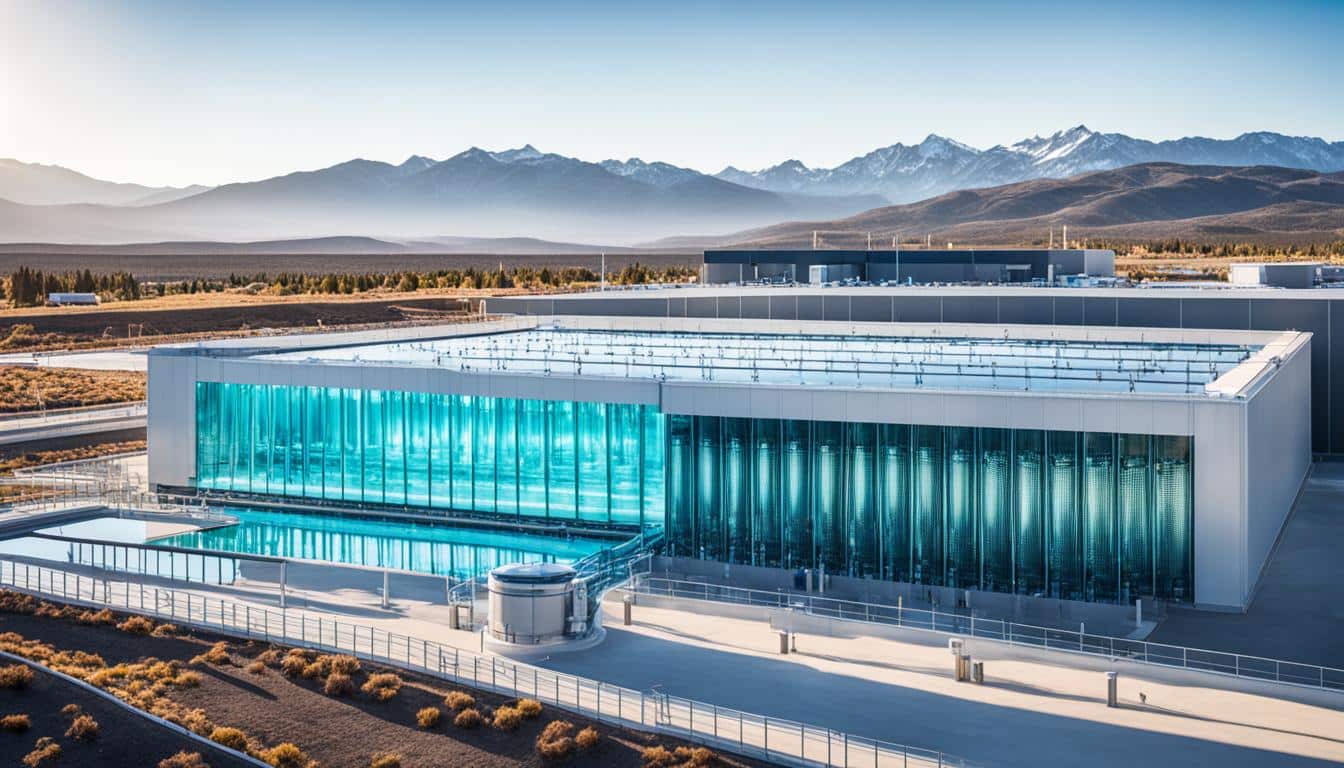
Did you know over 40% of the people worldwide face water scarcity? This highlights the urgent need for new water management tech. With climate change and growing populations, the issue is getting worse. But, new smart solutions are stepping up to improve both water use and its impact on our planet.
Digital technologies are changing how we manage water. Now, smart systems offer detailed insights to help decision-makers. These include modern desalination and wastewater treatments and water-saving tech from innovative companies. This new approach is also cheaper, saving resources and money.
Keeping an eye on water quality all the time is also key. This stops wasted water and helps the environment. Plus, local water systems are improving the reach of clean water. They also work on preventing floods and making water safe, aiming for a complete water management solution.
Managing water well is now more important than ever. With climate change and a growing world population, we are under a lot of pressure. Our goal is to find smart ways to use water sustainably without forgetting about quality and access.
Climate change brings about more and harder droughts and floods. This makes water scarce. Only about 2.7% of Earth’s water is fresh, with most of it either frozen or underground. Thanks to new technology, the water industry is changing for the better.
By 2050, the world’s population could hit 9.1 billion, needing more water. In India, each person used to have over 5,000 cubic meters of water every year. But, this has dropped to 1,545 and will drop further to 1,140 by 2050. Smart use of water is crucial for the survival of small farmers and handling water needs.
About 85% of India’s water goes to farming, supporting over half the country’s people. Technology that manages water better is critical here. For example, the S M Sehgal Foundation in India has helped over three million people since 1999. Their work focuses on improving water use and saving water.
| Year | Per Capita Water Availability in India (Cubic Meters) |
|---|---|
| Independence Era | 5,000+ |
| 2025 | 1,341 |
| 2050 | 1,140 |
Water use is growing faster than the population. We must use new technologies to tackle this. Accepting smart water management helps us handle the needs of a bigger population and deal with climate changes.
AI and the Internet of Things (IoT) are changing water management. They are making better systems. These new techs help organisations improve how they work. Efficiency and choices are getting better because of them.
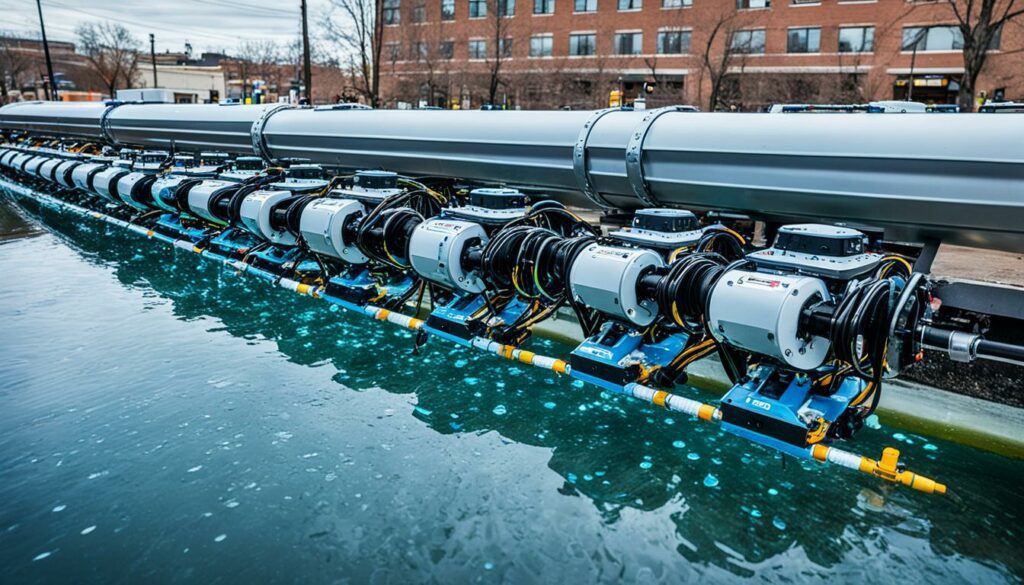
AI and machine learning can now predict water needs and find leaks. They also help distribute water better. Novion uses AI in its water solutions. FluksAqua has a tool for tracking water use in plants. This tool is making water monitoring much better.
Quensus, based in the UK, has a system called LeakNet. It uses smart technology to find leaks. This helps in using water more wisely. It shows how AI is making a big difference in managing water.
IoT is also important in water management. Startups like PipePredict and SPHERAG use IoT to watch water better, especially in farms. This helps save money and water.
SA Water uses IoT meters to tell customers how much water they use. This data is detailed and available often. It helps people use water smarter. And, it helps in finding problems like leaks early.
AI and IoT together are changing water management for the better. These tools are moving us towards a future where water is used wisely. This is good for our planet.
Smart irrigation systems are changing how we save water in farming, known for using a lot of water. They use the latest tech to use water better and improve how much crops grow.
Weather-based irrigation controllers help us use water smartly. They change when to water plants based on the current weather, like temperature and sunlight. A study by the Irrigation Association (IA) and the International Center for Water Technology found these systems can use up to 20% less water than older methods.
Particular regions have seen big water savings, from 30% to 50%. For example, in Washington State, special rain sensors cut water use by 20,735 gallons a year per area. This is more than twice the saving made by traditional methods, which saved around 10,071 gallons a year.
Soil moisture sensors are key in using less water in farming. They check the soil to see when it needs water. In tests, these sensors saved up to 72% of the water normally used, and 34% during dry spells. This shows how effective they are for using water wisely.
For home use, these sensors can cost between $99 and $165. More complex systems can range from $280 to $1,800. With the big water savings they bring, using these sensors is a major step towards saving water.
Not only do smart irrigation systems save water, they also help crops grow better. They use both weather-based controllers and soil moisture sensors. This shows the bright future of saving water in farming.
Desalination technology has taken big steps forward. It now uses smart water management and green energy. The goal is to make desalination good for the environment and also affordable.
Using solar and wind power has changed desalination for the better. It makes desalination plants cleaner and cheaper to run. Solar and wind power ensure these plants have the energy they need without using up oil. And this helps the planet by cutting down carbon emissions.
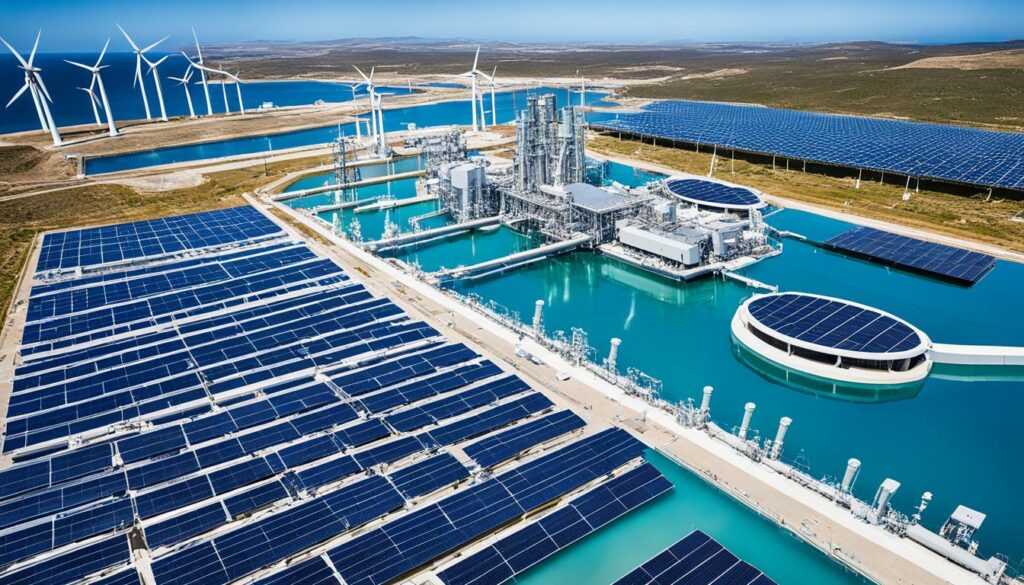
Desalination methods are getting cheaper and smarter. For example, new membranes can filter water more efficiently. This means we use less energy. Thanks to such advancements, the cost of making fresh water from seawater could drop a lot by 2030.
Also, these advanced methods are boosting recovery rates in desalination plants. They’re finding ways to use less water in the process. This makes desalination more efficient and affordable.
| Key Metric | Current Status | Projected Improvements by 2030 |
|---|---|---|
| Overall Recovery Rate | 40-50% | 55-60% |
| Energy Consumption | 2.1-2.4 kWh/m3 | Below 1.8 kWh/m3 |
| Cost of Water Production | 0.2-0.5 US$/m3 | Further 60% reduction |
There are new, green ways to desalinate water. These don’t use harmful chemicals. They’re working on a method to extract minerals from the process water. This could bring in money by getting minerals like magnesium and lithium.
This move towards cleaner desalination shows how it can be part of a sustainable water future.
Global water supplies are running low. But, many innovative technologies are stepping up to solve this issue. Advanced filtration technologies, for instance, have changed the game in water treatment. They make processes more efficient and help fight the water scarcity that already affects a quarter of the world.
Nanotechnology has massively improved water treatment. It allows for purer water in recycling and treatment. Companies like Nanoseen and Warranium are leading this field. They’re cutting down diseases like cholera by half and making treatment processes smaller.
Biological filtration is another key player in water purification. This method uses natural processes to remove harmful bits from water. It’s a green way to clean our water. With advanced water tracking, the quality is always top-notch. In areas that use this, water for people and farming has gone up by 20%.
Implementing these new technologies can be hard. They need a lot of money and skills to get going. But, they’re working on making things cheaper and easier. This way, everyone can get access to better water. It’s all about working together, investing, and making sure everyone on Earth has clean water.
Flood prevention and management have transformed with new technology. These advancements help protect places at risk from floods. They lessen the harm floods cause to people’s lives.
Using drones for predicting and watching floods is now very important. Drones can show us what’s happening in real time and take pictures from above. This helps us plan and act quickly to stop floods.
Drones and other tech work together to fight the dangers of natural disasters. They make up a strong system for protecting us.
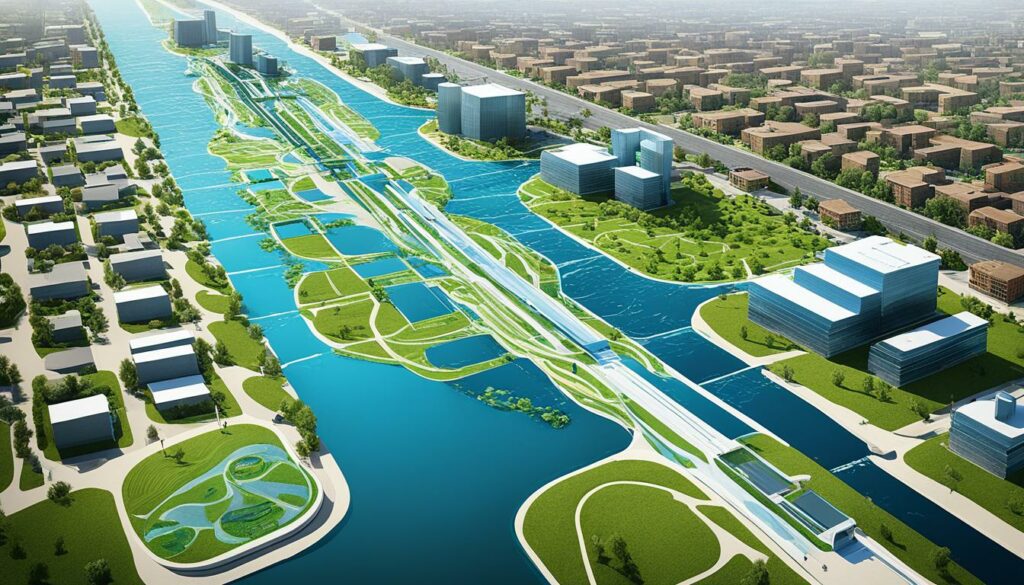
Better water systems play a key role in our flood defence. The Saint Petersburg Flood Prevention Complex in Russia is a great example. It has miles of dams to keep floodwaters back.
New Orleans has a lot of its land below sea level. It depends on a big system of walls and gates to stay dry. After the 1993 flood in the Midwest, many places were turned into wetlands. This helps keep floods away.
President Biden is working to improve our water systems. A big project in Duchesne got more than 28 million dollars to help rural places. This shows strong support for making better, smarter ways to avoid floods.
Decentralised water infrastructure is now key in modern management, moving away from old central systems. These new systems cut costs by handling water and waste locally. They are also strong against failures, only affecting a small area if they break down.
The AUC Lease Plant Program shows this well. It helps new places grow without big plant costs. This approach also makes dealing with rules easier, speeding up how quickly projects start.
Decentralised systems let communities choose from different finance options. They can pick short or long leases, or lease-to-buy deals. This makes it easy to bring water to places that need it fast. As communities grow, they can also expand their water systems, making sure it fits their needs.
These systems also help reuse local water, supporting smart water use and being eco-friendly. With billions lacking clean water and facing water crisis yearly, these systems are very important. They’ve been used for years and keep getting better, ready to meet future challenges from climate change and growth.
| Feature | Centralised System | Decentralised System |
|---|---|---|
| Initial Capital Outlay | More than 50% | Significantly Lower |
| Maintenance Costs | High | Reduced |
| Resilience to Failures | Lower | Higher |
| Scalability | Fixed | Flexible |
| Bureaucratic Hurdles | High | Limited |
| Financing Options | Fixed | Flexible |
Overall, using decentralised water systems is smart for saving water and the planet. It’s about using new tech and working together for a better future. With better flexibility, strength, and less red tape, these systems are ready for the world’s water issues.
Water reuse and recycling systems are key to managing water sustainably. They use membrane bioreactors and greywater recycling to treat wastewater. This treated water is then used for tasks that don’t require drinking water. These systems help lessen the pressure on fresh water.
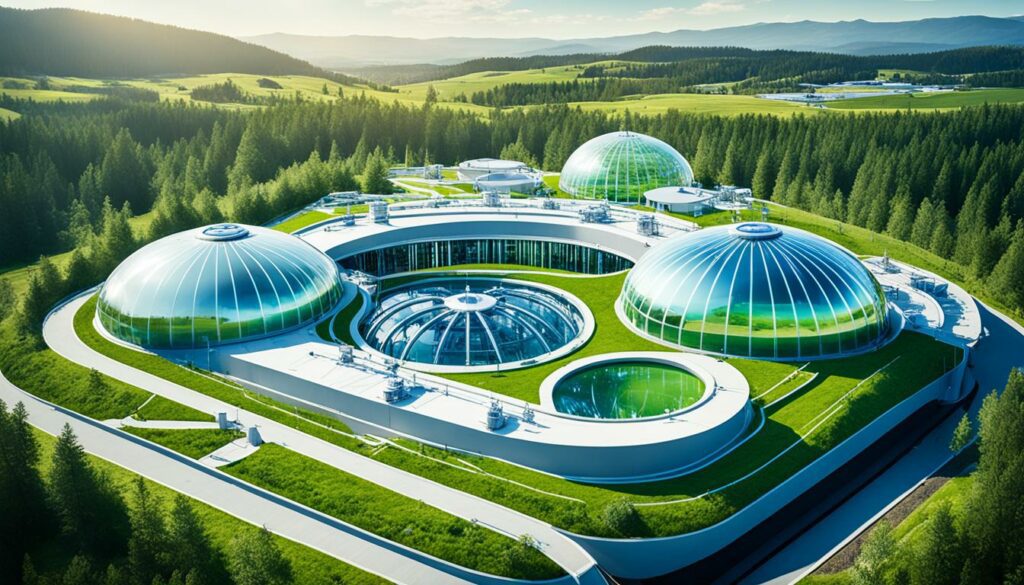
Indirect potable reuse (IPR) has been around since 1978. It’s governed by strict rules under Title 22. Membrane bioreactors have changed the game for treating wastewater. For example, in California, they use membranes and reverse osmosis for top results. The ZeeWeed part of Singapore’s Bedok NEWater plant first produced 11.3 mgd. The benefits include needing less space, less work, easier automation, and better removal of harmful organisms.
| Facility | Location | Capacity | Technology |
|---|---|---|---|
| Sulaibiya | Kuwait City | 112 mgd treatment | Membrane-based with 85% RO water recovery |
| Bedok NEWater | Singapore | 11.3 mgd initial production | Membrane bioreactors |
Including greywater recycling systems is vital in saving water. These systems clean water from baths, sinks, and washing machines. This water can then be used for tasks like watering plants and in some industries. Using recycled greywater means we use less fresh water, save money, and protect the environment. For example, Irvine Ranch Water District found that adding recycled water pipes in new buildings was only 9% of total plumbing costs.
The EPA says using water again saves lots of resources and money. Using water reuse and recycling systems is crucial for managing water in a smart way. It helps in many areas, from farming to making our cities greener.
Using less water in farming is vital today. Both climate change and more people push for this. These efforts make sure farming uses water well. This keeps farms going strong while being kind to the planet.
Precision farming has changed how we use water on farms. It uses GPS and other tech to manage water better. By being more accurate with water, less of it is wasted. Tools like soil sensors and drip systems help cut water loss:
| Technology | Water Savings |
|---|---|
| Drip Irrigation | Reduces water consumption by up to 70% |
| Soil Moisture Sensors | Reduce over-irrigation by up to 50% |
| GPS and Remote Sensing | Improves water efficiency by 20-30% |
AI and machine learning also boost water saving. They make smart choices to use resources better. This helps farms save water by 15-20% more.
Good water use methods in farming now mix many techniques. For example, using satellites and drones can make crops grow better.
This means a 10% jump in crop yield. Systems like wetlands and biofilters clean water before it’s used again. They remove almost all pollution from water used in farming.
Also, noting when to water, planting cover crops, and how to plough can save water. They improve the soil and cut pollution from farms too:
It’s crucial to blend precise farming with water-friendly habits. This mix boosts farm productivity and saves our planet’s water. By using new ideas in farming, we help save water and make fields flourish.
Artificial intelligence is transforming the way we manage water resources. It brings the power of real-time data analysis. This helps us quickly find and fix problems, improving our efficiency in managing water.
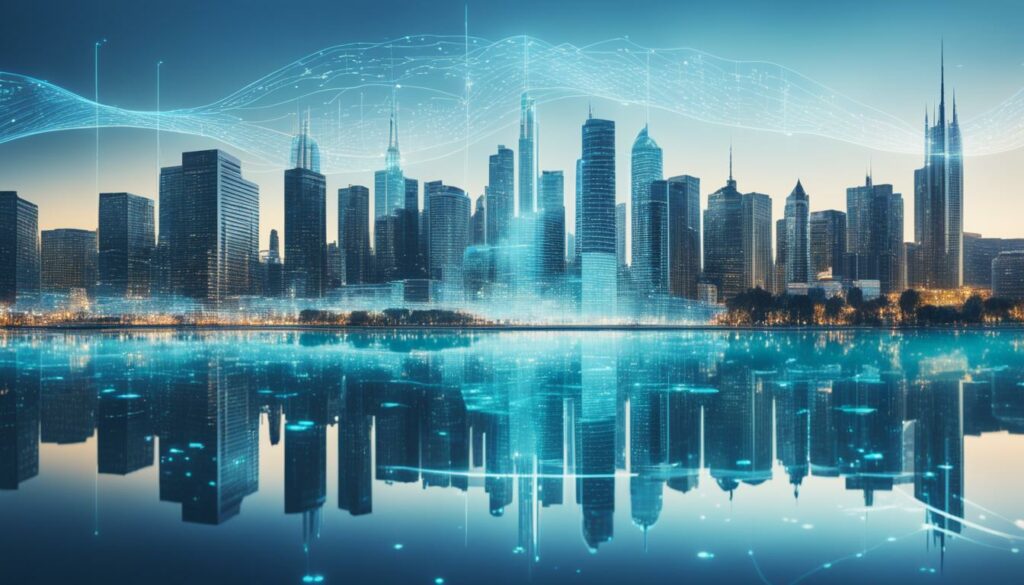
AI handles many tasks at once, connecting different pieces of data. This makes it great for predicting demand and maintenance needs. Working together with people, AI makes better use of resources and processes. This reduces waste and makes operations run smoother.
Using AI for predictive analytics is key in knowing how much water we need. AI looks at past data and today’s trends to use water efficiently. It helps cut down on waste, especially important as the world’s population grows. We are all counting on the same water, so using it wisely is crucial.
AI is changing the game in finding and fixing leaks. It uses special sensors to detect leaks as they happen. This fast action saves water and energy. AI is great at spotting when things aren’t running as they should. This keeps everything working smoothly.
Bringing AI into water management is a big leap towards a sustainable future. It’s gaining a lot of attention online. This shows more and more people understand how AI can help change water management for the better.
Lately, blue-green infrastructure has become very popular for city water management. It mixes natural water systems with man-made ones to solve many problems from urban growth and climate change. It makes cities ready for big storms and uses water wisely, changing the way cities live.
At its heart, blue-green infrastructure combines natural and created water systems. Places like wetlands, rain gardens, and green spaces help with city water. They manage stormwater, clean wastewater, and cool cities, showing how to smartly use water in cities. These methods not just stop floods. They also help plants and wildlife live in cities.
Blue-green solutions do more than help nature. They make cities deal well with water and protect against climate change and storms. They also collect stormwater to reuse, which is good for cities and the environment. These ways make cities healthier, promote saving water, and show a new way to plan cities.
Also, more people are learning about blue-green ways. For example, you can study saving water and growing green at Oxford University Press with a 30% off. This effort fits with making cities smarter and greener.
Water harvesting is key for sustainability, especially in dry areas. Two main methods are catching rainwater on roofs and land-based systems. These techniques are effective and efficient. Let’s look closer at what they are and why they matter.
Catching rain on rooftops is great for cities. It reduces water running off and harming the environment. These systems provide water for activities like washing, and they cut water costs for homes and businesses.
In places outside big cities, land catchments work well. They gather rain for farming or to refill groundwater. The success of such a system depends on its design. They’re also good for farms and factories, saving money by using less bought water.
Using roofs and land for water can involve the whole community. For cities, technology makes systems more effective by tracking weather and how much water is needed. This all helps save water, deal with droughts, and support sustainable living in both cities and the countryside.
The impact of climate change on our water is clear worldwide. In the last two decades, storage of land water has dropped by 1 cm each year. This has greatly impacted our water safety (WMO, 2021). As we face new obstacles, it’s vital to find new ways of managing water.
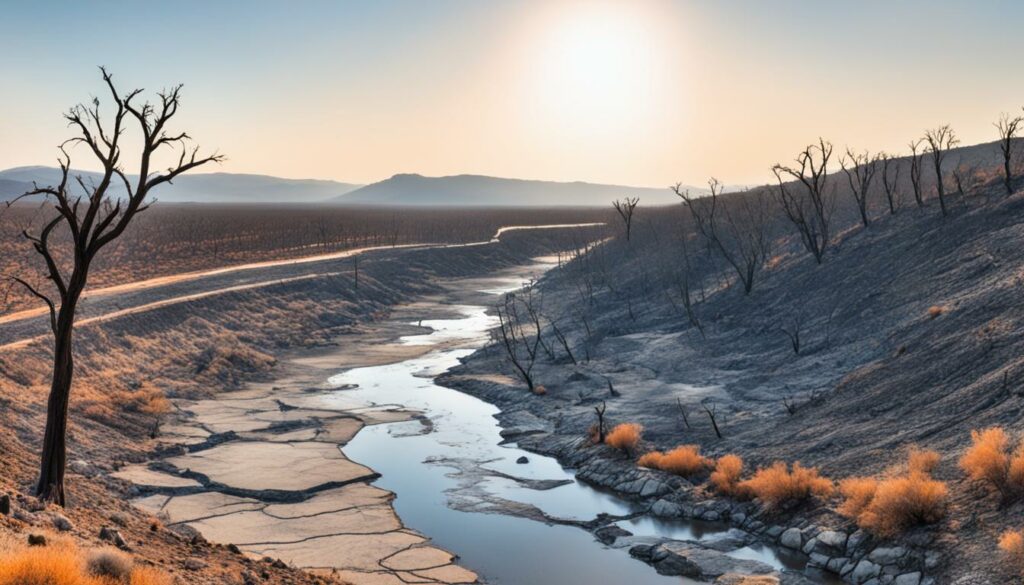
By 2050, the amount of people threatened by floods may rise to 1.6 billion (United Nations, 2020). At the same time, between 2.7 and 3.2 billion people could face serious water shortages (United Nations, 2020). We urgently need sustainable water solutions to lessen these threats.
Significantly, over 20% of the world’s inland waterways are showing big changes in size. This means water availability is shifting (UN-Water, 2021). It’s important to use new water management technology trends for a stable water supply. Adding new climate targets by 2030 is essential to keep within 2°C and 1.5°C global warming (UNEP, 2021).
The Arctic sea-ice is shrinking fast and might be ice-free before 2050 (IPCC, 2021). Also, the amount of moisture in the soil changes a lot, showing our water cycle is changing (USGCRP, 2014).
We must turn to sustainable water solutions in farming, building, and making energy. For example, in the United States, sea levels are rising. This makes coastal waters in places like Florida saltier, risking fresh water supplies (Anonymous Source).
In the West, rains have reduced in the past 50 years, causing worse and longer droughts, especially in the Southwest. The Northeast, Midwest, and upper Great Plains have seen more heavy rains, which have gone up by over 30% (Past 50 Years Data).
In ending, the big impact of climate change calls for strong and flexible water management technology trends and sustainable water solutions. These are vital to meet the changing challenges of our water supply.
In 2024, the water management field will see big technical steps. Companies will put more money into making smart water technology safe from cyber threats. This effort will keep our water systems safe and strong.
Drinking water treatment plants are getting more automated. They are using technology to work better and faster. This move is key to making our water systems sustainable.
Next year, look out for digital twins, AMI, GIS, and advanced leak tools. These new techs will help water systems work better and keep the water clean. They are especially important for wastewater plants.
The industry is changing to use more automation and digital tech. This change, along with green energy, will make water systems more environmentally friendly. It will also help make our cities smarter by improving how we control water.
Agriculture is focusing on smarter water use next year. This means using resources better and caring for the environment. New tech like smart soil sensors and AI plays a big role here, helping make water use more efficient.
In 2024, smart buildings and energy systems will also get better. This improvement is to use power more wisely and reduce pollution in cities.
| Top 8 Water Management Trends for 2024 | Leading Countries in Startup Activity |
|---|---|
| Digital Water Management | Netherlands |
| Wastewater Processing | US |
| Advanced Filtration | |
| Flood Prevention | |
| Water-saving Technology | |
| Decentralised Infrastructure | |
| Innovative Materials | |
| Desalination |
Cities are perfect places for sustainable water solutions. As they get bigger, using water smartly becomes more crucial. It’s vital to mix green solutions and tech to deal with water issues.
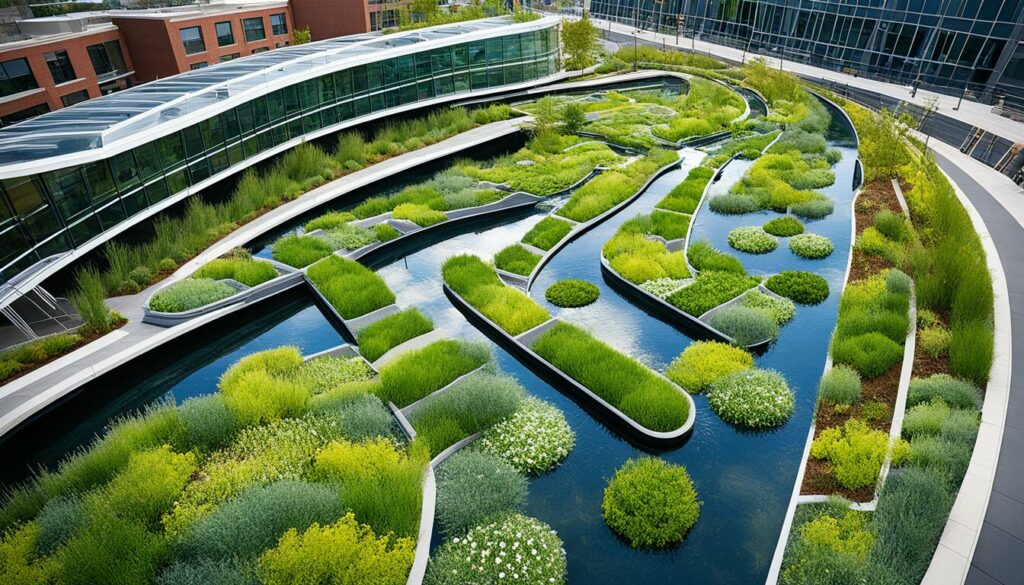
Smart city water management is key for cities to have efficient water systems. It uses IoT devices and smart meters to watch water use in real time. This helps find leaks quickly and saves a lot of energy. Also, updating old water pipes can use water better and reduce waste.
Urban areas are working hard on water-saving solutions. They use green gadgets and new tech. Green roofs and permeable pavements are good examples. They can keep up to 75% of the rain. City water can then be used for things like watering gardens and flushing toilets. This means less stress on sewers when it rains heavily.
Smart irrigation systems with sensors make watering gardens better. They use up-to-date weather information to water at the best times. This keeps our landscapes nice without wasting water. And with floods becoming worse, these ideas are super important. Water-sensitive urban design suggests having more green areas. It also talks about treating water nearby and collecting rainwater. All this protects city plants and looks nicer.
Urban floods often hit poorer areas the hardest, affecting health. So, caring for everyone and their needs in water plans is crucial. This includes making sure water solutions help life in cities get better. Smart ways of handling water mean happier city folks.
Today, managing water efficiently is top priority. Cutting-edge water monitoring technologies like smart meters and real-time water quality systems are crucial. They bring many advantages.
Smart meters change how we check water use. They find leaks fast and cut down on wasted water. Fixing 10 faulty meters reduced water loss by 34 million gallons yearly, saving over $1 million.
Installing 700 meters showed 86% were not working well. But fixing them saved over 353 million gallons. This made more than $10 million in extra money a year.
Real-time water quality monitoring uses the latest tech to watch water all the time. Companies like Planet Labs and its 120 satellites check water clarity quickly, often within three hours. This is key for farming and keeping an eye on the weather.
For example, in the Reventazón river area, these tools are used. There, 25% of San José’s water comes from and 85% of Costa Rica’s vegetables are grown. This late technology helps make sure the water stays clean and enough for everyone.
There’s also Global Water Watch. It gives info on water from space, helping managers use resources better.
The world of water management technology is changing fast. This change is key to tackling water shortages with smart and eco-friendly solutions. Devices like drip irrigation and micro-sprinklers make sure plants get water where they need it most.
They cut back on water lost through evaporation and runoff. This means they use less water than old methods. By avoiding waste, we can do more with less.
Soil moisture sensors are a big help too. They stop us from using too much water, saving it for when we really need it. And with artificial intelligence (AI) and the Internet of Things (IoT), farms are getting smarter.
This smart tech helps decide the best times to water and what to grow. Technologies that use GPS and special sensors are also playing a big role. They make sure we use water and nutrients in the most effective way.
Systems like biofilters and constructed wetlands clean up harmful stuff in water from farms. Then, technologies like membrane filtration help us use that water again. This cuts down on wasting water.
Using certain plants and ways of farming can also stop the land from losing nutrients and water. These efforts protect our water. It’s a team effort by governments, researchers, tech companies, and farmers.
Barcelona is a great example of how smart water use can work. Rainwater collection is growing in popularity too. These new ways of handling water mean a hopeful future.
By using the latest in water saving tech, we’re tackling the water challenges we face today. And we’re preparing for a future where water is safe and abundant. Cutting-edge water management and smart technology are key to this future.
Artificial intelligence (AI) and the Internet of Things (IoT) are boosting operational efficiency. They help in better desalination which uses renewable energy. Also, advanced technology makes water filtering more effective.
Climate change makes it harder to manage water. More extreme droughts and floods affect water availability and quality. Innovative solutions are needed, like smart water technology, for better forecasting and stronger infrastructure.
AI is changing water management for the better. It uses data for predicting demand and finding leaks. This leads to smarter decisions about where and how to use water.
Smart irrigation uses current weather and soil data to water more efficiently. It cuts down on water waste and helps crops as well. This is important in reducing the large water use in farming.
Desalination is getting greener with solar and wind power. This reduces harm to our environment. Companies like Oxyle and Algaesys are finding ways to use less energy in the process.
Nanotechnology and biological filtration are making water treatment better. They offer cleaner water and use less space. These methods are key to dealing with water shortages by reusing more water.
Technology is getting better at predicting and handling floods. Drones are used for keeping an eye on water levels. This, along with improved infrastructure, helps protect people and water supplies in tough times.
Decentralised water systems work on their own, not part of a big network. They bring clean water to places that are far from cities or are often forgotten. This is key for making sure everyone has water to drink.
Systems like membrane bioreactors and recycling greywater are used. They clean and reuse water that’s not for drinking. This lowers the need for fresh water for things like watering plants or manufacturing.
Precision farming knows exactly when and how much water crops need. It uses real-time data to avoid wasting water. This helps in using water smartly in farming.
BGI mixes natural and human-made systems to solve city water issues. Things like rain gardens and green roofs manage rainwater. This lowers the risk of floods and helps the environment.
Water can be collected from roofs and land. This gives cities and farms more water without using up what’s already there. It’s especially useful in dry times or to lessen the use of city water.
Thanks to smart city tech, water in towns is managed more wisely. This helps save water and makes urban life better. It’s in line with making cities more sustainable.
New water monitoring tech like smart meters offers real-time details on water use and quality. This allows for quick action when there’s a problem. It helps in using water well and taking care of water sources.